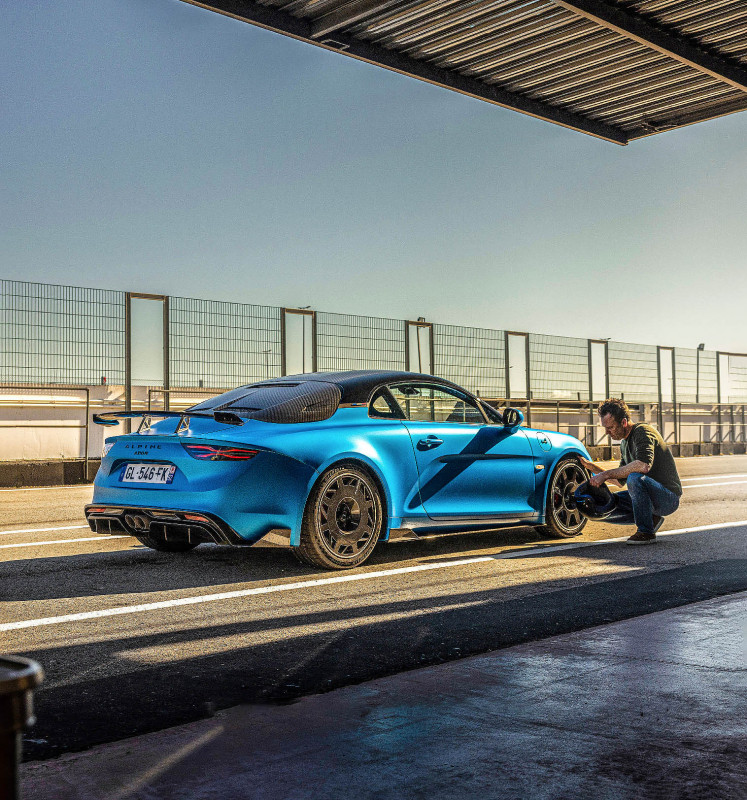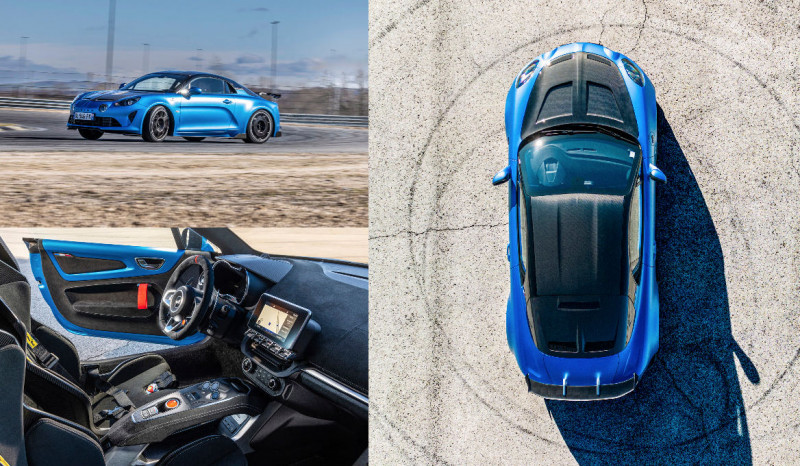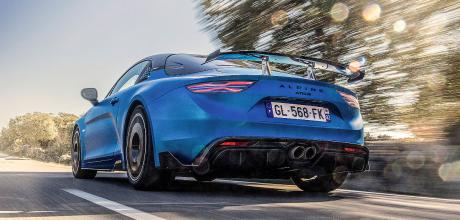300-Mile Test: 2024 Alpine A110R on road and track
Few ever tackle Porsche head-on, let alone its mesmerising Cayman GT4. Alpine has. We drive the serious – and ferociously expensive – A110R The last laugh.
ALPINE A110R
Words Ben Barry
Photography Charlie Magee
The 300-mile test
NEW CAR MEETS REAL WORLD 300-Mile Test: 2024 Alpine A110R on road and track. Does the most hardcore version to count as a Porsche beater?

The Alpine A110 never has been a big-numbers car. In fact, a distinct lack of them is part of the point – low weight, low power, little everything, relatively affordable. But threading through the hills north of Madrid in the new A110R, I do wonder if potential buyers might expect a few more numbers from the range’s hardcore halo.
Power from the R’s 1.8-litre turbo four is unchanged from A110S and GT siblings at 296bhp, weight falls only 34kg to – okay, blimey – 1082kg, aerodynamic downforce increases only 29kg at the rear versus the S and actually falls 33kg at the front for stability (read a little more understeer) in faster corners.

In fact, pricing makes for the most impressive figure of all – £89,990 is £38k over the base A110 and £28k pricier than an A110 GT or S. A Porsche Cayman GT4 is £8k more affordable. Bof!, as a French person might exclaim. But you quickly feel the key differentiator for this new model – its chassis, which brings more focus to a double- wishbone set-up that’s usually rather laissez-faire at managing roll and clinging onto grip.
Dampers are manually adjustable through 20 clicks (if you break out the spanners and jack up the car) and while the factory default is 10, Alpine’s engineers have got me in slightly firmer nine, their logic being it’s cold and a tad more heat in the tyres wouldn’t be a bad idea. They totally trust me though.
The R had seemed resolutely tough on patchwork tarmac after we’d collected it from Jarama race circuit to the north-east of Madrid, but up here on liquorice-smooth tarmac it’s all precision directness and weightless agility – still an A110, but a much more serious kind of package. We’re flying. You can carry speed and carve this chassis with a commitment simply not possible in lesser models, leaning on it hard and squeezing the performance like it’s the last of the lemons and there’s still a whole lot of torte to make. Ride quality is never an issue here. Roll? Not a lot. What you do get a whole load of is stickiness from the semi-slick Michelin Cup 2 tyres, even in the cold conditions that put the Alpine people on edge earlier. The same rubber’s optional on the less track-focused A110S and comes in identical 215/40 R18 front, 245/40 R18 rear sizes. Crucially, though, the S chassis wasn’t developed around the Cup 2s, where the R’s has been. It was overseen by Philippe Merimee (a Renault Sport veteran with some cracking hot hatches to his name) and finessed by former karter, Saxo Cup racer and long-standing Renault Sport/ Alpine test pilote David Praschl.
Complementing those 20-click ZF dampers, spring rates are 10 per cent stiffer than the S, anti-roll-bar stiffness increases 10 per cent front, 25 per cent rear, and suspension is lowered 10mm for road use but can be dropped a further 10mm for the track if you break out the specialised spanners. ‘We wanted to keep the A110 feeling and balance, but with better body control,’ is Praschl’s sell. These nicely rounded numbers are not plucked from thin air – dynamics engineer Maud Bouvet reveals Praschl can detect a three per cent shift in spring stiffness and comes looking for her with a grin if she’s changed the weight of the carbonfibre wheels even fractionally.
Only a belly-scraping ride height visually gives these chassis changes away, but the weight saving is in plain sight, the vast majority of it involving carbonfibre – used for the bonnet, roof, rear swan-neck spoiler and even the rear ‘screen’. Its quality is lush, with long flaw-free weaves of lacquered pre-preg carbon glistening like snakeskin in the sun. It makes for a particularly striking combination against signature Racing Matte Blue paint – the same textured finish used for the Alpine F1 cars and one that brings appropriate extra crispness to this hardcore A110’s otherwise cutesy lines. Six grand, though.
Two-piece carbonfibre wheels produced by Duqueine contribute a total of 12.5kg to the overall weight saving and add to the seriousness of it all – eight-spoke spider-like fronts but a more closed sunflower-style design at the rear to enhance aerodynamic efficiency (as do sideskirts that widen the R’s belly, smoothing flow).
While all these changes save only 34kg, credit where credit’s due – the A110 is already around 300kg lighter than any rival, so there’s little scope for chipping away. I don’t get off to the smoothest start with the trackday- vibe interior. Harnesses, homologated as standard, are the usual faff, with no pads to prevent them digging into my upper body, and I clonk my funny bone on the exposed carbon of Sabelt seats (a 5kg saving) while going through parachute-like contortions to buckle up.
Up to speed on the E5 autoroute towards Torrelaguna, though, the A110R isn’t just tolerable for long-distance excursions, it positively invites them – selective padding makes those spare-looking carbonfibre seats impressively comfortable and there’s good under-thigh support, the 1.8-litre turbo four’s gurgly burble is rousing rather than rowdy, there’s little road noise and even that lumpy low-speed ride smooths to a settled stride. Only the lack of a rear-view mirror (or replacement digital screen) annoys. When we turn off north on the M-124 just before Torrelaguna, the A110R snaps alive. Smooth, framed by armco and snaking through flatlands before rising up into the mountains, this road’s used as a rally stage on national events but could’ve been rolled out like a red carpet specially for the A110R launch – although in fact we’re offpiste, not following a route designed to flatter the car.
The firmed-up chassis leaves the electrically assisted steering a little meatier and better detailed as you tip it in, and a microfibre-wrapped thin rim introduces a welcome McLaren-like tactility. That 50-yard impression is quickly reinforced by everything else the driver interacts with, from the lack of squidge in the seats or suspension to the bite of a brake pedal that controls 320mm Brembos, the same fitted to the S and GT (if with enhanced cooling). No Chinese whispers between driver and tarmac here.
Bounding up hillsides and out of hairpins with gearshifts popping in via the paddleshifters, there’s a fruity, old-school kind of bustle to this highly charismatic four. It might be no faster than an S or GT on straights, but I’m travelling as rapidly as seems sensible through the turns and not once does it occur to me I should go back to Alpine with my begging bowl.
There’s much less weight transfer and bodyroll than in the A110. Versus the S, it’s the altered balance that’s most noticeable. It still couldn’t be anything other than mid-engined, with an eager, inertia-free front and a rear that can arc into a quicker corner off-throttle to tuck that nose in further, but the lack of roll and masses of grip mean that the R adopts a much more neutral stance mid-corner. This thing has grip forever in the dry, feeling reluctant to get exuberant even through coils of hairpins – and then becoming a little frantic when you do finally unstick it, a combination of mechanical grip and no limited-slip diff. Not playful, then, but on a road like this, where rhythm, momentum and precision are everything, it’s fantastic. We push on and up towards the Guadarrama mountain range, following a snaking route that cuts through pine forests, squeezes between rock faces and passes through Valsain and Navafria before finally spitting us back out where we started near Torrelaguna. What a loop – it’s like canoeing down boulder-strewn rapids. Then next morning I’m in the Jarama pits chatting with product boss Oliver Sommer and dynamics duo Merimee and Praschl. Before our track session there’s chance to experiment with those trick dampers. Car jacked, you twist a red collar at the top of the coilover unit, feeling out each click in a delicate motion somewhere between expert safe-cracking and fearful cow-milking. I lose track of where I am and Merimee has to sort it all out.
I don’t actually get to put theory into practice as the schedule unfortunately doesn’t leave time for lapping on different settings, but we are on the 10mm lower track-only suspension setting for circuito use.
Not used for F1 since 1981 but still a fixture on the Spanish Supertouring championship, Jarama flicks between tighter cambered turns that put a premium on braking, low-speed agility and traction, and faster, frequently blind sections that ask more of stability. The session backs up our road-driving experience: endless body control and mechanical grip, and a sense that Alpine has dialled down the playfulness in favour of a more serious, more planted feel. When I stamp on the brakes for a big stop, there’s precious little dive and certainly little sense that an unsettled rear wants to waltz past the front. Through blind downhill flicks the R shrugs off mid-corner braking and quick changes of direction.
This is obvious stuff that comes with R territory. More revealing is the balance. The R will rotate eagerly into a corner if you trail it in on the brakes while turning, but it quickly settles to a more neutral attitude that lets you divebomb the apex like Verstappen. Go harder in the midspeed to quicker stuff and there’s some front-end push in the name of stability, and it feels unhappy and a little scrappy when forced to oversteer. If you want to mess about, you might think the R’s lost its sense of humour; if you want to work on dropping tenths from your lap time, you’ll find it mostly satisfying.
But track work does put the spotlight on the R’s modest power, because while daring yourself to carry more and more corner speed is a rush, you’ll inevitably start craving extra power to exploit the R’s balance in corners and tap additional straight-line speed.
The A110R is expensive, no more powerful than less expensive siblings and has suspension that requires a trolley jack rather than a press of a button each time you want to adjust it. A lot of people won’t get it. I’d tweak mine for a less neutral balance, and more performance on track wouldn’t go amiss. And while it was perfectly at home on super-smooth Spanish asphalt, we need to see just how it copes with UK roads.
But the A110R is also a whole load of fun straight of out the box and will doubtless be one of those cars we’ll look back on in 10 or 20 years, barely able to believe they were able to green-light it. Or… given the electric A110 successor is due only three years from now, maybe we’ll be looking back in 2026 thinking ‘They made this? Wow.’ Future classic sooner than you think.
Through blind downhill flicks the R shrugs off mid-corner braking and quick changes of direction
TECHNICAL DATA2024 Alpine A110R
- PRICE UK 2023 £89,990
- POWERTRAIN ENGINE 1798cc 16v turbo four-cylinder,
- TRANSMISSION seven-speed dual-clutch auto, rear-wheel drive
PERFORMANCE
- MAX POWER 296bhp @ 6300rpm,
- MAX TORQUE 251lb ft @ 2400rpm,
- ACCLERATION 3.9sec 0-62mph,
- MAX SPEED 177mph
- ON SALE Now 2023
- WEIGHT 1082kg
- EFFICIENCY 40.3-41.5mpg (official), 160g/km CO2
- RATING ★★★★★
- PLUS + Agile; massive grip and body control; improved steering; cabin comfy despite hardcore focus
- MINUS — Seriously expensive; S-spec power and no more; faffy suspension adjustment
ALTERNATIVES
- Porsche 718 Cayman GT4 More affordable, powerful, playful, and spacious. No-faff suspension adjustment
- Lotus Emira More affordable and powerful; better steering; no faffy suspension adjustment.…
Bounding out of hairpins there’s a fruity, old-school kind of bustle to this highly charismatic four
No power increase? Actually no Problem. Spoiler and wheels are R specific; cabin more comfortable than it looks. R’s chassis was set up around its trackfriendly tyres.
VERDICT
- Pick-up: 0 miles We collect the car from the Jarama circuit, improvise ourselves a road route for the rest of the day, then return to get in some laps the next morning.
- 5 miles In damper setting nine of 20, low-speed ride feels very firm on patchwork roads but eases with speed. General comfort fine on the motorway.
- 18 miles This sat-nav gets us about well enough but it would feel a bit low-rent in an entry-level Renault Clio, never mind a £90,000 rival to a Porsche.
- 60 miles Carbon quality looks particularly lush in late afternoon sun, thanks to long, straight weaves by Carl Composites. Fashion and function.
- 102 miles Chassis engineer Maud Bouvet talks us round the R’s Duqueine carbon wheels and 20-click adjustable dampers/ adjustable ride height.
- 146 miles A warning pings if you don’t buckle up. At a snack stop, I whack my funny bone on otherwise comfy carbon seats while adjusting them. Ouch.
- 209 miles Carbon rear screen looks cool but no rear-view mirror and no digital replacement gives you that UPS feeling. There is a reversing camera and screen.
- 276 miles Chatting through damper settings with ride and handling chief engineer Philippe Merimee and programme director Xavier Sommer.
- 309 miles Jarama alternates between twisty and fast. A110R feels grippy, composed and neutral. Could be quicker. Could be more playful. But I like it a lot.


